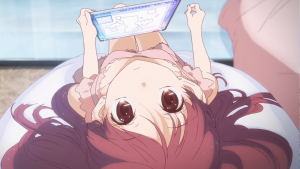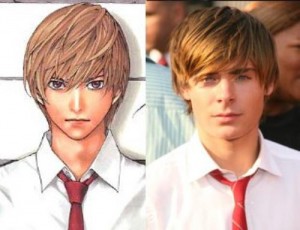What Constitutes An Anime?
 Yeah, guys. We’re talking about “Shelter” today. Everyone else that is even marginally connected to anime is doing it, so… Sure, why not? It’s not like I’m going to be original about it… And besides, I did discover it before it blew up! Hang on, let me put on that scarf and fedora I keep around here… Seriously though, the funny story about “Shelter” is that I actually discovered it through the YouTube algorithm when it only had a little over a thousand views, and I sent it to a bunch of friends telling them “Holy crap, you guys totally need to watch this”, and of course not a single one of them watched it. And later on, when everyone and their mother realized that “Shelter” is one of the best animated music videos of all time, garnering over 3.5 million views at the time of this writing, suddenly those very same people were sending it to me. Gotta love it. In any case, don’t be dumb like my friends and go watch “Shelter” if you haven’t already. It’s 6 minutes long, and I promise you every second is worth it.
Yeah, guys. We’re talking about “Shelter” today. Everyone else that is even marginally connected to anime is doing it, so… Sure, why not? It’s not like I’m going to be original about it… And besides, I did discover it before it blew up! Hang on, let me put on that scarf and fedora I keep around here… Seriously though, the funny story about “Shelter” is that I actually discovered it through the YouTube algorithm when it only had a little over a thousand views, and I sent it to a bunch of friends telling them “Holy crap, you guys totally need to watch this”, and of course not a single one of them watched it. And later on, when everyone and their mother realized that “Shelter” is one of the best animated music videos of all time, garnering over 3.5 million views at the time of this writing, suddenly those very same people were sending it to me. Gotta love it. In any case, don’t be dumb like my friends and go watch “Shelter” if you haven’t already. It’s 6 minutes long, and I promise you every second is worth it.
Anyway, my friends’ idiocy aside, there was another incident which happened pretty early on in the short’s lifespan which kind of helped boost its popularity even further, because as we all know controversy sells. /r/anime is one of the biggest communities for sharing anime stuff around, and that’s because it’s a very tightly moderated subreddit (subforum of the social media site Reddit). Off-topic threads get deleted pretty quickly, there are dedicated topics for each currently airing series, that kind of stuff. Overall, the moderators have been doing a pretty great job. Well, naturally, “Shelter” was uploaded there and immediately reached the top, garnering hundreds of thousands of upvotes… before promptly disappearing, never to be heard from again. The moderators even went as far as to add a script to the subreddit which automatically removed any threads with the word “Shelter” in their name or body. Why would they go to such extremes to ban this amazing short film?
Well… Because according to them, it’s not anime.
And if you haven’t actually watched the video, I can see you going “Yeah, that makes sense, just because something looks anime-ish doesn’t make it anime – I mean, look at Avatar or Teen Titans, those aren’t anime!” But anyone who has actually seen the short is probably going “Huh? It’s not?” After all, “Shelter” looks, sounds and even smells like anime! It wasn’t just inspired by anime, it decidedly feels like anime. It would look right at home airing on Japanese TV. The voice acting (what little there is of it) is all in Japanese. The color palette is just right. Honestly, the only non-anime thing about it is the song that plays over the music video, which features English vocals, but that’s about it. And the reason why the short feels so natively Japanese is because… Well, it was, um… Actually made in Japan, by Japanese people. You know, like all anime.
The short was made at the Japanese studio “A-1 Pictures”, which are responsible for anime classics like “Anohana”, “Sword Art Online”, “Black Butler”, “ERASED”, “OreImo” and many others, including “Persona: Trinity Soul”, but hey, we all make mistakes. They’re masters of their craft, with years of experience in the anime field and numerous legendary series behind their belt. So, it’s an anime-styled short that was made entirely by a Japanese studio, right? How come it’s not anime? Is it because of the music? Well, sort of. The thing is, “Shelter” is a passion project of Porter Robinson – a highly successful musician and avid anime fan. It’s his song, also titled “Shelter”, that plays over the animation, and the entire concept and storyline was his idea, with Robinson also acting as a producer, funding the project himself with some help from streaming service Crunchyroll. It’s his involvement, apparently, that disqualified “Shelter” from being considered anime. Because, you know… If the team behind an anime has a single white person on board, regardless of their role, then I’m really sorry, but that anime is no longer anime. It’s, um… Something. I’unno. No, seriously, you think I’m exaggerating? This is what one of the mods of /r/anime had to say about it:
“This is a music video by an artist that contracted out a studio that happens to also produce anime. If A-1 was contracted to produce episode of Spongebob, we wouldn’t allow that either.”
Woooooooooow. Just wow. Apparently, someone missed the memo stating that “Shelter” is not “Spongebob”. Well, at least this exchange gave us the “Spongebob is an anime” meme, which will probably circulate on Reddit for a little bit until it goes to that big deadpool in the sky when people move on. This whole thing begs the question – why did this happen in the first place? Well, two reasons. First of all, many hardcore anime fans (as in, the people who live and breathe anime, to the point where they do very little else with their lives) are kiiiind of sticklers when it comes to technicalities. To them, everything in anime must meet a certain set of criteria, or otherwise it doesn’t count no matter how obvious it is. For example, many anime fans don’t consider “Code Geass” to be a mecha anime because the giant robots in it aren’t the main focus like they are in, say, “Gundam”. So if one of the criteria for defining a certain piece of art as “anime” is “It’s produced by an entirely Japanese team”, the presence of a single white guy on the team has forever ruled out that particular artwork as “not anime” in their mind. Second of all, Reddit admins in general do tend to be a little bit totalitarian, banning people who disagree with their own views even when no rules have been broken and removing threads at their own personal discretion rather than by the community’s request.
Soon after “Shelter” was taken down from /r/anime, the sheer pressure from the userbase caused the mods to restore the original thread, even if they did so begrudgingly. Still, that whole debacle raised a whole lot of interesting questions. Is anime a set of criteria that need to be kept, or is it more of an artstyle? Why is something like, say, “Panty & Stocking”, which looks decidedly less like a traditional anime and more like a Western cartoon, considered anime just because it covers some arbitrary criteria while “Shelter” is not? In 100 years, when everyone involved in the creation of “Shelter” is dead, will it still matter who was white and who was not, or will the work be judged on its own merit? Or am I just overthinking an incident that lasted for a few hours and was triggered by a six minute short? Probably the latter, but… Hey, that’s what I’m here for, right?

 Next year, we’ll actually be getting not one, but two major Hollywood productions based on anime series – “Ghost in the Shell”, starring Scarlett Johansson, and “Death Note”, starring Nat Wolff. Both adaptations have been trying to get off the ground for a really long time now (“The Matrix” was originally supposed to be a “Ghost in the Shell” adaptation, but the Wachowskis didn’t think they’d get the rights, so they took some main themes and styles and presented them in their own way, while “Death Note” had a failed adaptation with Zac Efron, which was a real shame because Zac Efron is literally Kira), so I’m actually really excited to see how they turn out! You already know that
Next year, we’ll actually be getting not one, but two major Hollywood productions based on anime series – “Ghost in the Shell”, starring Scarlett Johansson, and “Death Note”, starring Nat Wolff. Both adaptations have been trying to get off the ground for a really long time now (“The Matrix” was originally supposed to be a “Ghost in the Shell” adaptation, but the Wachowskis didn’t think they’d get the rights, so they took some main themes and styles and presented them in their own way, while “Death Note” had a failed adaptation with Zac Efron, which was a real shame because Zac Efron is literally Kira), so I’m actually really excited to see how they turn out! You already know that